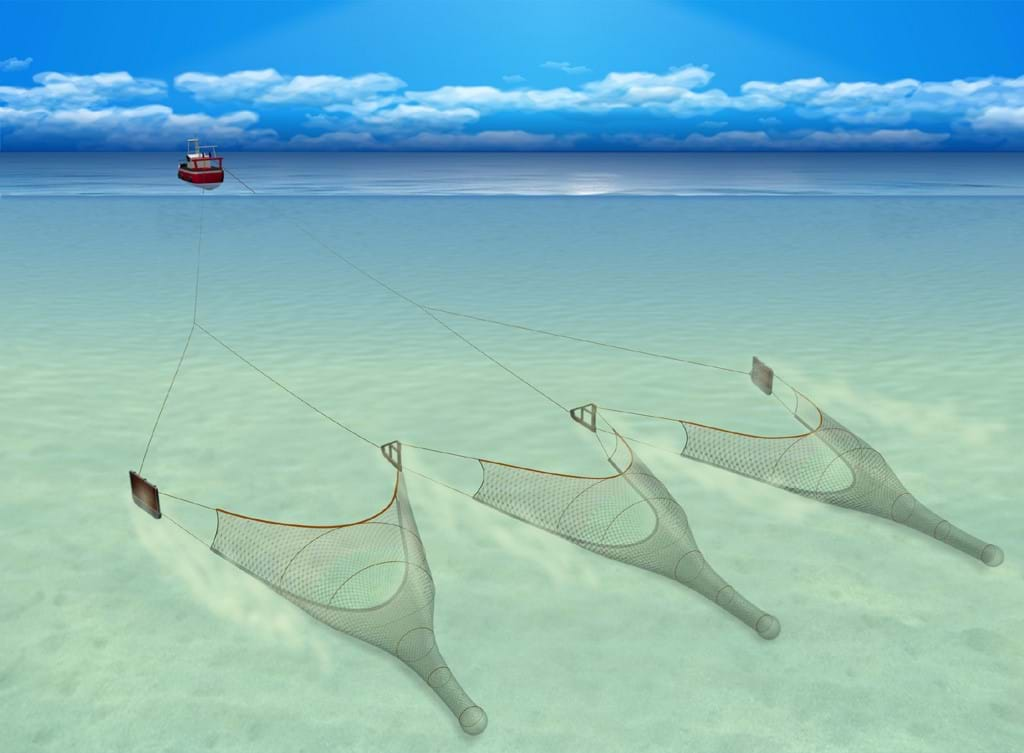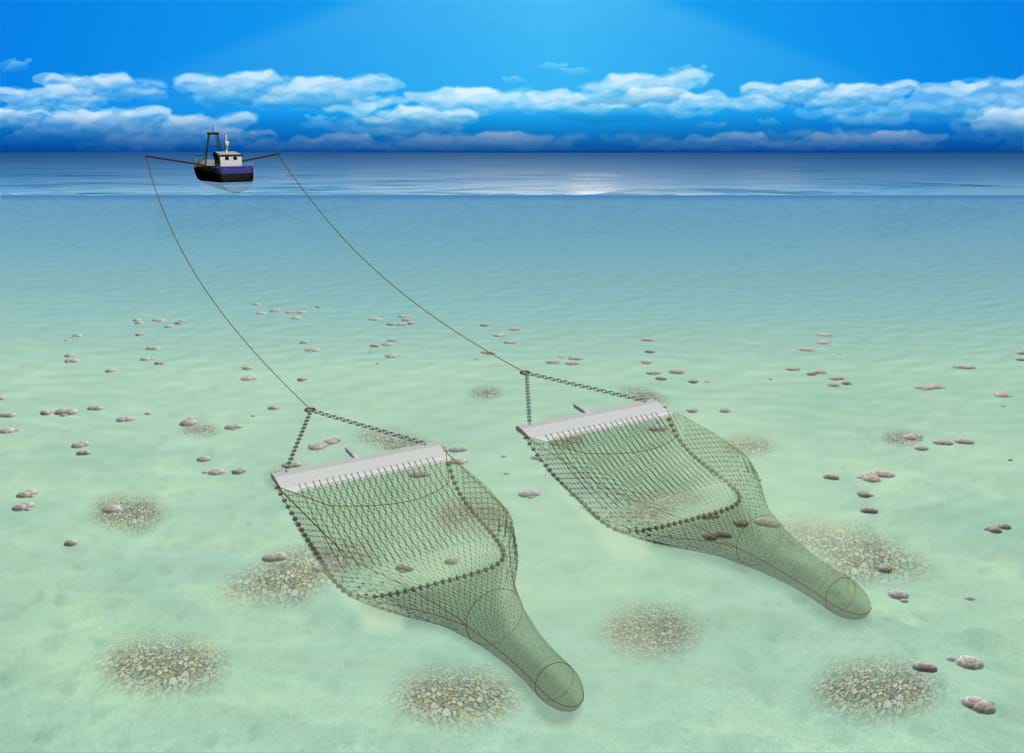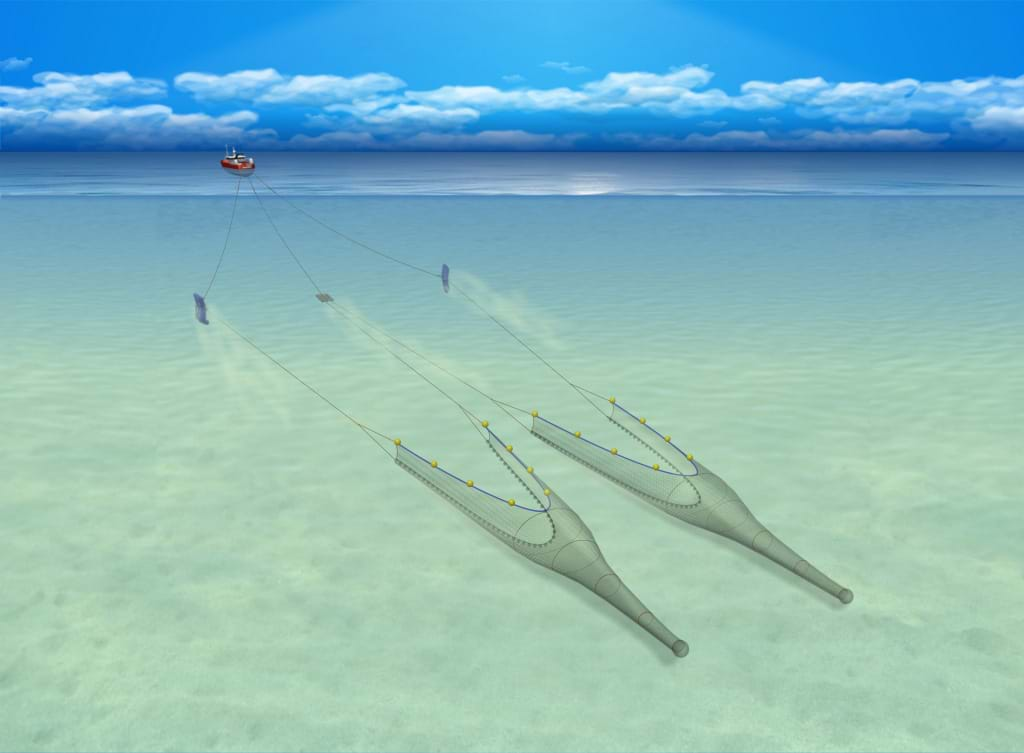Types of fishing gear
This page has information on:

Some of the most commonly used types of fishing gear can be split into three categories – static gear, encircling gear and towed gear.
Static gear
Static gear is set to allow fish to swim into it, or to attract fish by bait, and consequently become caught in the gear. Some of the main types of static gear are:
- Gill nets: Often used as a general term referring to gill nets, trammel nets, wreck nets and tangle nets.
- Lining: Extremely long lines that can be left either anchored or drifting, with numerous baited hooks.
- Pots and traps: Structures into which fish are guided or enticed through funnels that encourage entry but limit escape.
Encircling Gear
Encircling gear is set in a circular form to enclose a shoal of fish or a large area of water or seabed. Gradually, the circle is closed up until the fish enclosed within it are captured. This includes:
- Ring net: A net operated by surrounding a shoal of pelagic fish with a ‘wall’ of netting, often operated by two boats.
- Purse seine: A large net used to surround a shoal of pelagic fish, the bottom of which is then drawn together to enclose them.
- Beach seine: An encircling net shot from a small boat and then drawn ashore by ropes.
- Anchor seine: An encircling net shot in the open sea using very long ropes to lay out the net and ropes on the seabed, prior to hauling from a boat at anchor. This is sometimes called a Danish seine.
- Scottish seine: An encircling net shot in the open sea using very long ropes to lay out the net, and ropes on the seabed prior to towing the net closed and hauling from a boat under its own power. This is sometimes called fly-dragging or fly-shooting.
Towed Gear
Towed gear is towed through the water, either on or off the seabed, to overrun the target species or herd them into the net. This includes:
- Beam trawl: A trawl towed on the seabed in which the net is held open by a wood or steel beam.
- Demersal trawl: A trawl towed on the seabed, held open by a pair of trawl doors. It usually uses a much larger net than a beam trawl.
- Pelagic trawl: trawl towed in mid-water to catch pelagic fish.
- Pair trawl: Trawl towed between two boats, either on the seabed or in mid-water, held open by the distance apart of the two vessels.
- Twin rig trawl: A method of towing two otter trawls side by side.
- Multi rig trawl: A method of towing two or more otter trawls side by side.
- Dredge: A rigid structure towed on the seabed, usually used for shellfish.

We have produced materials with further information on commonly used fishing methods, gears and rigs. They cover UK fisheries and other global fisheries that supply fish and shellfish for UK markets. They also provides some basic knowledge of how fish are caught using a range of fishing methods.
Fishing gear database
We've created an easy to use online fishing gear database tool, which can be accessed using the link below. It allows you to browse, filter and search records for different types of gear – some records also contain video content and links to additional resources.
Basic fishing methods handbook
If you’d prefer to access information in a document you can download a copy of our basic fishing methods handbook from the link below. It contains illustrations and descriptions of commonly used gears and rigs.

The fishing methods and gear you use can make a huge difference to the quantity and quality of the fish you catch and sell. When considering which fishing gear best suits your needs, it’s important to think about a variety of factors including:
- target species
- size of your fishing vessel
- common fishing methods used in the area
- gear design, efficiency and how it is operated
- the environmental impact of the gear
Buying new fishing gear can be an expensive investment. Most vessel owners or skippers will consult gear manufacturers who can offer advice and guidance before buying. Three major factors to consider when choosing fishing gear are selectivity, gear efficiency and fuel efficiency
Selectivity
Selectivity refers to the measurement of the selection process of a fishing gear. It is a comparison of the length and frequency of each species caught to that of the total population available to catch. Gears with better selectivity improve catches by reducing discards. Gear selectivity can be improved with the inclusion of square mesh panels, cod-ends, inclined grids and large mesh panels.
Gear efficiency
Gear efficiency is about maximising catch value in relation to fuel consumption. This makes fishing more cost-effective and profitable. For example, towed gears can be monitored and assessed using electronics to ensure that the gear is operating optimally. However, some smaller vessels may have to rely more on the skipper's expertise. Multi-rigs can often improve efficiency by reducing gear drag. Efficiency is constantly being improved in nets, trawl doors, warps and other aspects of gear.
Fuel efficiency
70-80% of fuel consumption is spent on towing fishing gear. Fuel flow meters can be used to help skippers to monitor their engine's efficiency and fuel consumption over time, and many skippers find that small reductions in revs result in substantial reductions in fuel usage. We have also tested the results of fuel additives and produced a factsheet on carbon emissions via fuel use in the fishing sector.
Further information on gear selectivity and efficiency can be found on our website from the link below:
If you are interested in undergoing training in the use of fishing gear you can attend Trawl Gear Technology Training. You can find out more about this on our website from the link below.
Contact us
For further information on types of fishing gear please contact:
How are we doing?
We'd love to hear what you think about us and our work. Click the link below to answer three quick questions